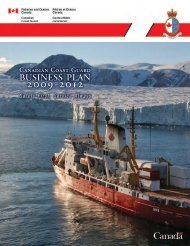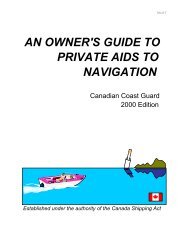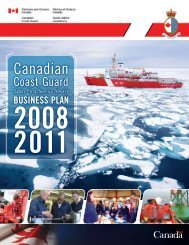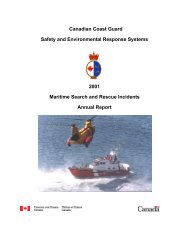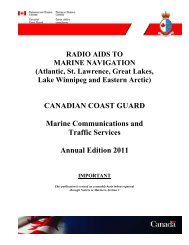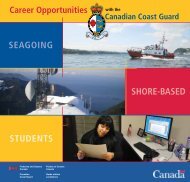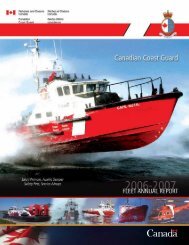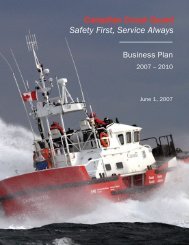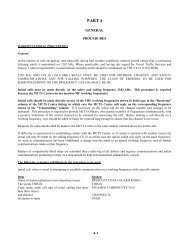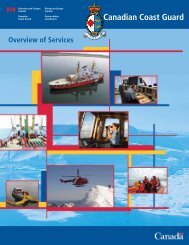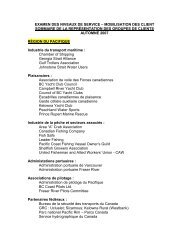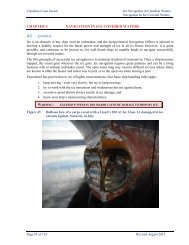RADIO AIDS TO MARINE NAVIGATION - Canadian Coast Guard
RADIO AIDS TO MARINE NAVIGATION - Canadian Coast Guard
RADIO AIDS TO MARINE NAVIGATION - Canadian Coast Guard
Create successful ePaper yourself
Turn your PDF publications into a flip-book with our unique Google optimized e-Paper software.
Mariners should also report in and out of any other restricted channels in the Delta at their own discretion.<br />
All vessels should maintain a continuous radio watch on the Western Arctic Emergency and Calling Frequency, 5803 kHz<br />
(SSB), from the time that they reach the first reporting point previous to entering a danger area until the time that they<br />
report clear of the danger area.<br />
If contact cannot be made with the Inuvik MCTS Centre on 5803 kHz, VHF Ch 16 (156.8 MHz) may be used where<br />
available either directly or through another ship, for possible relay to the Inuvik MCTS Centre.<br />
The Safety Advisory calls should consist of the following information:<br />
(a) Name of towing vessel and number of barges in the tow and whether riding high or low;<br />
(b) Direction of voyage i.e. northbound, southbound, etc.;<br />
(c) Danger Zone;<br />
(d) Mileage;<br />
(e) Time;<br />
(f) Remarks.<br />
EXAMPLE:<br />
Inuvik <strong>Coast</strong> <strong>Guard</strong> Radio this is Kitikmeot, southbound with 6 barges riding high, entering Area 6 at Mile 680,<br />
1030 Local estimating Mile 660 at 1530 local, have you any traffic?<br />
If contact cannot be made with Inuvik MCTS, either directly or through another ship, the vessel shall broadcast her<br />
position to advise any vessels in the area.<br />
CANADA / UNITED STATES CO-OPERATIVE VESSEL TRAFFIC SYSTEM AGREEMENT<br />
In 1979 by formal agreement, the <strong>Canadian</strong> and the United States <strong>Coast</strong> <strong>Guard</strong>s established the Co-operative Vessel Traffic<br />
System (CVTS) for the Strait of Juan de Fuca region. The purpose of this agreement is to provide for a co-operative<br />
system of vessel traffic management in the applicable waters in order to enhance safe and expeditious movement of vessel<br />
traffic while minimizing the risk of pollution of the marine environment.<br />
Co-operative Vessel Traffic Services (CVTS)<br />
Participation with Tofino, Seattle, and Victoria Traffic is mandatory within <strong>Canadian</strong> and U.S. territorial waters. Though<br />
participation seaward of <strong>Canadian</strong> and U.S. territorial waters is voluntary, vessels are strongly encouraged to participate to<br />
receive the full benefit of the Vessel Traffic Services available further offshore, typically about 50 nautical miles. These<br />
benefits include traffic information, warnings of vessel congestion or other hazardous conditions, and many other forms of<br />
transit assistance.<br />
Tofino Traffic<br />
West <strong>Coast</strong> Approaches to Juan de Fuca Strait<br />
Vessel Traffic Services from 124 40 00 W in Juan de Fuca Strait westward to the 127° West meridian of longitude, and<br />
intersecting to the south to 48° North parallel of latitude from the west coast of Washington State are provided by the CCG<br />
from the Tofino MCTS Centre at Amphitrite Point, BC (Tofino Traffic).<br />
All communications with vessels in these areas will be conducted on VHF Ch 74 (156.725 MHz).<br />
3-10



